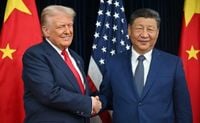In a week marked by high-stakes diplomacy and pointed warnings, the United States and China signaled a cautious thaw in their often-fraught relationship, even as tensions simmered in the South China Sea and across the broader Indo-Pacific region. The latest developments unfolded in the wake of a historic meeting between U.S. President Donald Trump and Chinese President Xi Jinping in Busan, South Korea, on October 30, 2025—a summit that both sides hailed as a turning point for bilateral ties.
Just days after the Trump-Xi summit, U.S. Secretary of War Pete Hegseth met with China's Minister of National Defense, Admiral Dong Jun, on the sidelines of the 12th ASEAN Defence Ministers’ Meeting – Plus (ADMM-Plus) in Kuala Lumpur, Malaysia. According to Fox News, Hegseth described the encounter as a "positive meeting" and announced that the two countries would establish new military-to-military communication channels. The goal? To "deconflict and deescalate any problems that arise." Hegseth emphasized, "The Admiral and I agree that peace, stability, and good relations are the best path for our two great and strong countries."
This move comes as Washington and Beijing have spent years trading barbs and flexing military muscle across the Indo-Pacific. The South China Sea, in particular, remains a volatile flashpoint, with overlapping territorial claims from China, the Philippines, Vietnam, Malaysia, and Brunei. The U.S. has long positioned itself as a counterweight to China’s assertiveness, deepening partnerships with regional allies through forums like the Quad and bolstering military presence from the Taiwan Strait to the Ladakh frontier.
Yet, as reported by The Associated Press and Fox News, Hegseth’s diplomatic overtures in Malaysia were paired with a sharp message to Southeast Asian nations. At the ASEAN meeting, he urged member states to "stand firm and strengthen their maritime forces to counter China’s increasingly destabilizing actions in the South China Sea." He did not mince words, stating, "China’s sweeping territorial and maritime claims in the South China Sea fly in the face of their commitments to resolve disputes peacefully. We seek peace. We do not seek conflict. But we must ensure that China is not seeking to dominate you or anybody else."
The dual approach—offering both an olive branch and a warning—was not lost on analysts. Bridget Welsh, a Southeast Asian political analyst quoted by The Associated Press, noted, "This is damage control. More importantly, it reflects two different currents in U.S. relations with China—one that sees China as a threat and another a possible partner."
Hegseth’s call for regional solidarity was underscored by the Philippines’ recent clashes with China’s maritime fleet. Manila, a key U.S. ally, has repeatedly urged a stronger regional response, but ASEAN nations have traditionally sought to balance caution with economic ties to Beijing, the region’s largest trading partner. The friction was further inflamed when China designated the contested Scarborough Shoal—a territory seized from the Philippines in 2012—as a "nature reserve," a move Hegseth condemned as "yet another attempt to coerce new and expanded territorial and maritime claims at your expense."
Chinese officials, for their part, pushed back forcefully. As reported by The Associated Press, Tian Junli, spokesperson for China’s People’s Liberation Army Southern Theater Command, labeled the Philippines a "troublemaker" after Manila staged naval and air drills with the U.S., Australia, and New Zealand. "It further proves that the Philippines is the troublemaker in the South China Sea issue and a saboteur of regional stability," Tian said.
Despite these tensions, both U.S. and Chinese leaders have publicly emphasized the benefits of renewed dialogue. In a post on Truth Social following the Trump-Xi meeting, President Trump declared, "My G2 meeting with President Xi of China was a great one for both of our countries. This meeting will lead to everlasting peace and success. God bless both China and the USA!" Hegseth echoed that optimism, writing on X, "I just spoke to President Trump, and we agree—the relationship between the United States and China has never been better. Following President Trump’s historic meeting with Chairman Xi in South Korea, I had an equally positive meeting with my counterpart, China’s Minister of National Defense Admiral Dong Jun in Malaysia. And we spoke again last night."
The practical upshot of these diplomatic exchanges is the planned establishment of direct military communication channels between Washington and Beijing. As Hegseth put it on X, "Admiral Dong and I also agreed that we should set up military-to-military channels to deconflict and de-escalate any problems that arise. We have more meetings on that coming soon." Such channels are intended to reduce the risk of accidental conflict in contested areas—a longstanding concern as both nations’ warships and aircraft routinely cross paths in the region.
While the U.S. and China take tentative steps toward military dialogue, Washington is also deepening its security ties elsewhere. On November 1, 2025, Hegseth and India’s Defence Minister Rajnath Singh signed a 10-year Framework for the US-India Major Defence Partnership, signaling stable ties as the two countries negotiate on trade and the thorny issue of tariffs related to India’s purchase of Russian oil. Singh described the agreement as "a signal of our growing strategic convergence" and said it would "herald a new decade of partnership." Hegseth described the framework as advancing the India-U.S. defense partnership, a "cornerstone for regional stability and deterrence," according to The Indian Express.
India, however, is watching the U.S.-China defense engagement with measured caution. Sources in Delhi told The Indian Express that India would not "jump to conclusions" about the renewed dialogue and would "assess the purpose behind the engagement," noting that it could potentially work in productive ways. The delicate balancing act reflects a broader regional anxiety: while military-to-military talks between Washington and Beijing could reduce the risk of miscalculation, they might also shift the strategic landscape in unpredictable ways.
Meanwhile, the U.S. is pressing for broader regional cooperation to counter Beijing’s influence. Hegseth urged ASEAN to finalize a long-delayed Code of Conduct with China to govern behavior in the South China Sea and proposed developing shared maritime surveillance and rapid-response systems. "A shared maritime domain awareness network," he said, "would ensure that any member facing aggression and provocation is not alone." He also welcomed plans for an ASEAN-U.S. maritime exercise in December 2025 aimed at strengthening coordination and upholding freedom of navigation.
For all the high-level meetings and diplomatic pleasantries, the underlying realities remain complex. The South China Sea is still a powder keg, and the Indo-Pacific’s security architecture is in flux. The U.S. is attempting to walk a fine line—balancing deterrence against China with opportunities for engagement, all while reassuring allies and partners that their interests won’t be sidelined.
As the dust settles from this week’s whirlwind of diplomacy, one thing is clear: the stakes are high, and the world is watching. Whether the new military-to-military channels between the U.S. and China will yield lasting stability—or simply buy time as deeper disputes fester—remains to be seen. For now, both sides appear willing to talk, and in this region, that counts for something.


